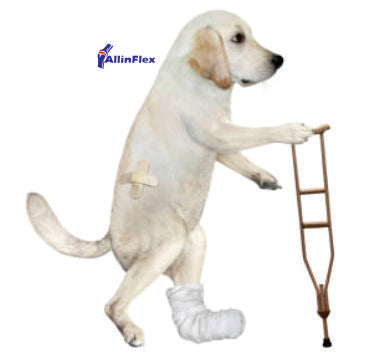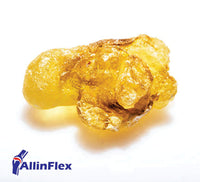Dog Bone, Joint and Ligament injuries which require Veterinarian care
Saskia OstermeierWhen your beloved pet suffers from a bone or joint fracture, or a ligament injury, understanding their recovery journey may give you piece of mind.
A dog bone fracture refers to any situation where there's a disruption in the integrity of the bone.
This could range from simple scenarios where the dog's bone splits into two segments, or more complex conditions known as comminute fractures, where the dog's bone shatters into several pieces.
Particularly severe is a type of fracture known as a compound fracture. In these cases, not only is the bone broken, but the break extends to the point of tearing the skin above it.
This exposes the internal tissues to potential contaminants, adding another layer of risk for the dog, to an already serious situation.
Each kind of dog bone fracture comes with its own set of challenges.
- In simple fractures, although the bone has only split into two pieces, proper alignment and stability are crucial for healing. Misaligned bones can prolong recovery, or worse, heal incorrectly, leading to longer-term health issues for your dog.
- Comminuted fractures, on the other hand, are even more complicated for the dog due to the bone shattering into multiple fragments. This often requires more intensive treatments, such as surgery, to ensure that each fragment is returned to its correct position. Without proper care, a comminuted fracture could lead to long-term damage and potential disability.
- Compound fractures present an additional risk: the risk of infection. Since the skin is broken, bacteria from the external environment can enter the wound, potentially leading to serious infections. Immediate and appropriate medical attention is vital to clean the wound, prevent infection, and treat the underlying fracture.

With all fractures, it's crucial to remember that immediate veterinary care is the best course of action for your dog.
A prompt examination and treatment plan can make all the difference in your dog's recovery and long-term health. Pain management, rest, and close monitoring of the healing process are all key components of managing bone fractures in dogs.
Spotting and Responding to Dog Bone Fractures
Identifying dog bone fractures can be challenging, especially if the injury isn't immediately apparent. To better detect an injury, here are some typical symptoms you may notice:
- Discomfort or pain at the injury location
- Difficulty in movement or reluctance to use the injured limb
- Signs of swelling or bruises on the skin around the injury
- An unnatural bend or deformity in the affected limb
Most dog bone fractures are the result of some form of trauma.
This could range from a severe accident like being hit by a car, to a seemingly insignificant event like leaping off a piece of furniture. However, a small percentage of fractures are associated with diseases such as neoplasia or infections that weaken the bone structure, leading to what's known as pathological fractures.
For a concrete diagnosis, several tests can be utilized:
- X-rays: These are usually the first step. Sedation might be advised to ensure the comfort of your pet during the procedure.
- CT scans: These can provide more detailed images, especially for fractures in areas like the spine, skull, or jaw.
Treatment for dog bone fractures varies depending on the bone involved and the nature of the break:
- Surgical repair: This is typically used for fractures in weight-bearing bones or those critical for joint movement. Depending on the fracture type and location, various methods may be used, including plates and screws, bone pins and wires, external fixators, or intra-medullary nails.
- Cast or splint: For some fractures, a cast or splint may suffice to provide stability while the bone heals. Your vet will assess the fracture and advise on this.
- Minimally invasive procedures: In some cases, small incisions and continuous X-rays (fluoroscopy) may be used to fix the fracture, a method known as Minimally Invasive Plate Osteosynthesis (MIPO).
Post-operative care for your dog is vital for recovery:
- Rest: Limited activity is strongly recommended for the initial 4-6 weeks after surgery.
- Follow-up: Regular X-rays will be taken to monitor the healing progress and adjust the permitted activity level accordingly.
- Splints or casts: These might be required post-surgery and typically need changing every 1-2 weeks until no longer necessary.
- Healing time: Several factors, including the dog's age, fracture location, and injury severity, can influence healing time. Most fractures heal within 6-12 weeks, but some may take longer.
- Physical therapy: This can be beneficial in some cases to maintain muscle strength during recovery. The surgeon will discuss this on an individual case basis.
- Bone and Joint Supplements: support the bone and joint structures to receive the proper nutrients for optimal recovery.

Understanding the Impact of Ligament Injuries on Dogs
A dog's ability to move and walk normally greatly depends on the health of its ligaments and tendons. These crucial structures, which connect bones to other bones at the joints, act as the framework that enables your dog's movement.
When in a healthy state, ligaments ensure joint stability, allowing for natural and fluid motion. They stretch to accommodate the dog's movements, keeping the joints securely connected.
However, a torn ligament can drastically disrupt a dog's movement.
This injury can be incredibly painful and can significantly impede the dog's natural motion. Once a ligament is torn, the affected joint loses its stability. This means that the joint may struggle to twist, bend, or move as it usually would.
The path to recovery after a ligament injury can be a long and arduous one. Full recovery could take several months, during which your dog's regular activity will likely need to be significantly curtailed.
While some dog ligament injuries might heal without intervention, many cases necessitate surgical procedures, combined with a lot of rest and rehabilitation therapy for a complete recovery.
Bear in mind that each dog's recovery timeline will vary.
Still, you should generally several months. It could be weeks before your dog is ready to bear the full weight on the injured leg again.
During this time, it's crucial to monitor your dog's progress closely and adhere strictly to the recommended treatment plan. Post-operative care may include medication, physical therapy, and adjustments to your pet's exercise and diet.
Regular follow-up visits to the vet are also essential to ensure that the healing process is going smoothly and to make any necessary adjustments to the treatment plan.
Additionally, dog owners should be prepared for behavioral changes during this period.
Dogs with ligament injuries may show signs of depression or irritability due to their limited mobility and ongoing discomfort.
Providing emotional support and keeping your dog engaged with toys and interactive games can help alleviate these symptoms and boost their mood during the recovery phase.
In conclusion, understanding the role of ligaments and the impact of their damage can help dog owners navigate the recovery journey with more confidence. It's a long road, but with patience, care, and the right treatment, your dog can bounce back from a ligament injury.
Understanding Ligament Tears in Dogs: Acute and Chronic Injuries
Ligament tears in dogs can be classified into two main types: acute and chronic. Acute ligament tears are characterized by a sudden rupture, usually due to a traumatic injury.
Dogs suffering from an acute ligament tear might not show noticeable signs of pain or injury until their ability to walk is affected.
On the other hand, chronic ligament tears develop over an extended period. This slow degeneration of the ligament gradually worsens with time.
In these cases, dogs might display only minor signs of discomfort initially, but these symptoms will exacerbate as the damage progresses, eventually leading to a complete tear if left unaddressed.
Identifying Signs of Ligament Tears in dogs
Look out for the following indicators that could point to a possible ligament tear:
- Sudden onset of pain
- Inability to bear weight on the affected leg
- Restricted motion in the injured joint
- Audible popping or crackling noises from the affected joint
Common Ligament Injuries in Dogs
Among ligament injuries in dogs, the most frequently encountered is a cruciate tear in the knee, often referred to as a Cranial Cruciate Ligament (CCL) tear. However, ligament tears are not limited to the knee. Other potential areas of injury include:
- Achilles tendon
- Ankle ligaments
- Shoulder ligaments
Distinguishing Between a Tear and a Sprain
Although they might seem similar, a ligament tear and a sprain are two distinct injuries. A sprain happens when a ligament is overstretched or twisted due to a fall or injury, which could also result in a strain. Conversely, a ligament tear involves the actual ripping of the tissue.
Generally, a ligament tear is more severe than a sprain, necessitating a longer recovery period and intensive rehabilitation. While a minor sprain or strain might be classified as a Grade 1 injury, a complete rupture or tear is considered a more serious Grade 3 injury.

Treating Ligament Tears in Dogs
Treatment for ligament tears in dogs depends on the severity of the injury and the health condition of the dog. Acute tears, owing to their sudden onset and potentially severe nature, often necessitate prompt veterinary intervention, which could include surgery.
Post-surgery, dogs usually need a period of rest and rehabilitation to regain strength and mobility in the affected area.
Chronic ligament tears may initially be managed with conservative treatments like rest, weight management, and physical therapy. However, as these injuries progressively worsen over time, surgical intervention might eventually become necessary.
Regardless of the injury type, pain management is a critical component of treating ligament tears. Medications to relieve pain and reduce inflammation can help make your dog more comfortable during the healing process.
Rehabilitation and Recovery for your dog
Post-injury rehabilitation is crucial for a full recovery, especially in the case of ligament tears. Rehabilitation might include physical therapy exercises to strengthen muscles and improve joint flexibility, as well as hydrotherapy for low-impact, resistance-based exercise.
During the recovery period, it's important to keep your dog's activity levels controlled and consistent. Over-exertion could risk re-injuring the healing ligament.
Preventing Ligament Injuries in dogs
Prevention is always better than cure. While accidents can't always be avoided, keeping your dog at a healthy weight, ensuring they get regular exercise, and avoiding activities that put undue stress on their joints can help lower the risk of ligament injuries.
Always consult with a veterinary professional if you suspect your dog has a ligament injury. Early detection and treatment can greatly improve your dog's prognosis and quality of life.




